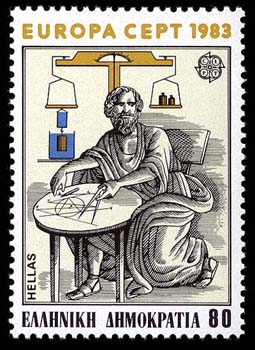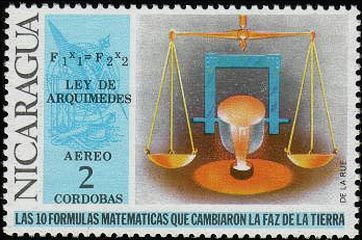.
Often times Archimedes’ servants got him against his will to the baths, to wash and anoint him, and yet being there, he would ever be drawing out of the geometrical figures, even in the very embers of the chimney. And while they were anointing of him with oils and sweet savors, with his figures he drew lines upon his naked body, so far was he taken from himself, and brought into ecstasy or trance, with the delight he had in the study of geometry.Plutarch
Though Archimedes discovered many curious matters which evince great intelligence, that which I am about to mention is the most extraordinary. Hiero, when he obtained the regal power in Syracuse, having, on the fortunate turn of his affairs, decreed a votive crown of gold to be placed in a certain temple to the immortal gods, commanded it to be made of great value, and assigned an appropriate weight of gold to the manufacturer. He, in due time, presented the work to the king, beautifully wrought, and the weight appeared to correspond with that of the gold which had been assigned for it.
But a report having been circulated, that some of the gold had been abstracted, and that the deficiency thus caused had been supplied with silver, Hiero was indignant at the fraud, and, unacquainted with the method by which the theft might be detected, requested Archimedes would undertake to give it his attention. Charged with this commission, he by chance went to a bath, and being in the vessel, perceived that, as his body became immersed, the water ran out of the vessel. Whence, catching at the method to be adopted for the solution of the proposition, he immediately followed it up, leapt out of the vessel in joy, and, returning home naked, cried out with a loud voice that he had found that of which he was in search, for he continued exclaiming, in Greek, eurhka, (I have found it out).
After this, he is said to have taken two masses, each of a weight equal to that of the crown, one of them of gold and the other of silver. Having prepared them, he filled a large vase with water up to the brim, wherein he placed the mass of silver, which caused as much water to run out as was equal to the bulk thereof. The mass being then taken out, he poured in by measure as much water as was required to fill the vase once more to the brim. By these means he found out what quantity of water was equal to a certain weight of silver.
He then placed the mass of gold in the vessel, and, on taking it out, found that the water which ran over was lessened, because, as the magnitude of the gold mass was smaller than that containing the same weight of silver. After again filling the vase by measure, he put the crown itself in, and discovered that more water ran over then than with the mass of gold that was equal to it in weight; and thus, from the superfluous quantity of water carried over the brim by the immersion of the crown, more than that displaced by the mass, he found, by calculation, the quantity of silver mixed with the gold, and made manifest the fraud of the manufacturer.
Vitruvius
A famous anecdote, that Archimedes leapt naked from his bathtub and ran through the streets of Syracuse shouting "Eureka" ("I have found it") after solving a problem, some say is unlikely. In the Vitruvius version, Archimedes notices that when he steps into a tub full to the brim with water, some water spills from the tub. Vitruvius wrote that Archimedes placed a weight of pure gold equal to the weight of the wreath in the tub and then filled the tub to the brim. Archimedes then supposedly took out the gold and replaced it with the wreath, reasoning that a wreath adulterated with silver would occupy more volume than an equal weight of pure gold, and would cause water to spill.
The Great Seal of California with Eureka (for the discovery of Gold)
But Rorres challenged this version, saying that the amount of spillage would have been much too small to measure using the means at Archimedes' disposal. Instead, Archimedes would probably have invoked his own Law of Buoyancy and Law of the Lever, first balancing the gold weight against the wreath in air and then balancing the two objects in water. An imbalance in water would clearly reveal adulteration, he said.
Be that as it may, Archimedes scorned the practical devices he designed as intellectually inferior to his mathematical theorems, and none of his writing refers to devices or engineering. In his will Archimedes asked that a cylinder circumscribing a sphere be placed on his tomb, illustrating what he apparently considered the most important geometrical relationship he had proved. If a sphere is inscribed in a cylinder, then the sphere is 2/3 of the cylinder in both surface area and volume.

Greece 1983 Stamp, Scott 146, Michel 1514. Explanation of the Archimedes Principle. See the weighing machine, on the left side with 2 objects, on the right side with a solid object inside the water of a container and a container filled with water with the same volume as the solid object. The scale shows that both weights on the left and right side are equal. They are also equal if we keep the right solid object and remove both water containers

The weighing machine is a special case of Archimedes “Law of the Lever” F1*x1 = F2 * x2 (x1 = x2). One of 10 mathematical formulas that changed the face of the world according to this Nicaraguan stamp.(Nicaragua 1971, Las 10 formulas matematicas que cambiaron la faz de la tierra, Michel 1613-1622, Scott 877-881, C761-C765)
Archimedes observation has been formalized into Archimedes Principle:
“An object partially or wholly immersed in a fluid, is buoyed up by a force equal to the weight of the fluid displaced by the object.”
Buoyancy is caused by the increase in fluid pressure at increasingly greater depths. The pressure on a submerged object is greater on the parts more deeply submerged, and the buoyant force is always upward, or opposite to the gravitational force; it is the net effect of all the forces exerted on the object by the fluid pressure.
Archimedes, Letter to Dositheus, c. 220 BC:
Archimedes to Dositheus, greeting: Formerly I sent to you the studies which I had finished up to that time together with the demonstrations, which were to show that a segment bounded by a straight line and a conic section is four-thirds of the triangle on the same base as the segment and of the same height. Since that time certain propositions as yet undemonstrated have come to my mind, and I have undertaken to work them out. These are: 1. The surface of any sphere is four times the surface of its greatest circle; 2. The surface of any segment of a sphere is equal to the surface of that circle the radius of which equals the straight line drawn from the vertex of the segment to the circumference of the circle which serves as the base of the segment; 3. That a cylinder with a base equal to the great circle of a given sphere, and a height equal to the diameter of the sphere contains half the volume of that sphere and its surface is equal to half the surface of that sphere.
These propositions, of course, were always true of these figures, but they were hidden to the men who studied geometry before my time. Therefore, since I have discovered that these things hold true of these figures I do not fear to place them alongside my own previous results and the most thoroughly established theorems of Eudoxus, such as: any pyramid is equal to one-third of the prism of the same base and height, and any cone is equal to one-third of the cylinder of the same base and height.
First Postulate. Supposed that a fluid is of such a character that when its component parts are undisturbed and in immediate contact the part which is subject to the less pressure is moved by the part which is subject to the greater pressure; and that each part is forced in a perpendicular direction by the part above, if the fluid is compressed.
Proposition 1. If a surface is always cut by a plane passing through a given point, and if the section thus formed is always a circle whose center is the given point, the surface is that of a sphere.
Proposition 2. The surface of any still fluid is always the surface of a sphere whose center is the center of the earth.
Proposition 3. Those solids which are of the same weight as a fluid in proportion to their size, when sunk in that fluid will be submerged in such a way that they neither extend above that fluid nor sink below it.
Proposition 4. A solid which is lighter than a given fluid will not sink below the surface when placed in that fluid, but part of it will extend above the surface.
Proposition 5. A solid lighter than a given fluid will, when placed in that fluid, be so far submerged that the weight of the solid will be equal to the weight of the fluid displaced.
Proposition 6. If a solid lighter than a given fluid be forced into that fluid the solid will be driven upwards again by a force which is equal to the difference between the weight of the fluid and the weight of the amount of fluid displaced.
Second Postulate: If a solid lighter than a given fluid rest in that fluid the weight of the solid to the weight of an equal volume of the fluid will be as the part of the solid which is submerged is to the whole solid.
Archimedes book On Floating Bodies is divided in two parts:
In the first part of this book, Archimedes spells out the law of equilibrium of fluids. He proves that water around a center of gravity will adopt a spherical form. This is probably an attempt at explaining the spherical shape of the Earth. His fluids are not self-gravitating but he assumes the existence of a point towards all things fall and derives the spherical shape.
In the second part he calculates the equilibrium positions of sections of paraboloids. He probably uses the paraboloid shape as an approximation of the shapes of ships' hulls. Some of his sections float with the base under water and the summit above water.
LINKS
ARCHIMEDES HIS TRACT De INCIDENTIBUS HUMIDO, OR OF The Natation of Bodies upon, or Submersion in, the Water, or other Liquids. 1662 Edition
Archimedes, A Gold Thief and Buoyancy by Larry "Harris" Taylor. (PDF File) Simple explanation of Diving and Buoyancy
Buoyancy Physics
Archimedes Floating Paraboloid (PDF)
Archimedes Floating Paraboloid from a Lecture (MS Word File)
Eureka, the journal of the Archimedeans, the Mathematics Society of the University of Cambridge
| Ancient Greece
Science, Technology , Medicine , Warfare, , Biographies , Life , Cities/Places/Maps , Arts , Literature , Philosophy ,Olympics, Mythology , History , Images Medieval Greece / Byzantine Empire Science, Technology, Arts, , Warfare , Literature, Biographies, Icons, History Modern Greece Cities, Islands, Regions, Fauna/Flora ,Biographies , History , Warfare, Science/Technology, Literature, Music , Arts , Film/Actors , Sport , Fashion --- |

